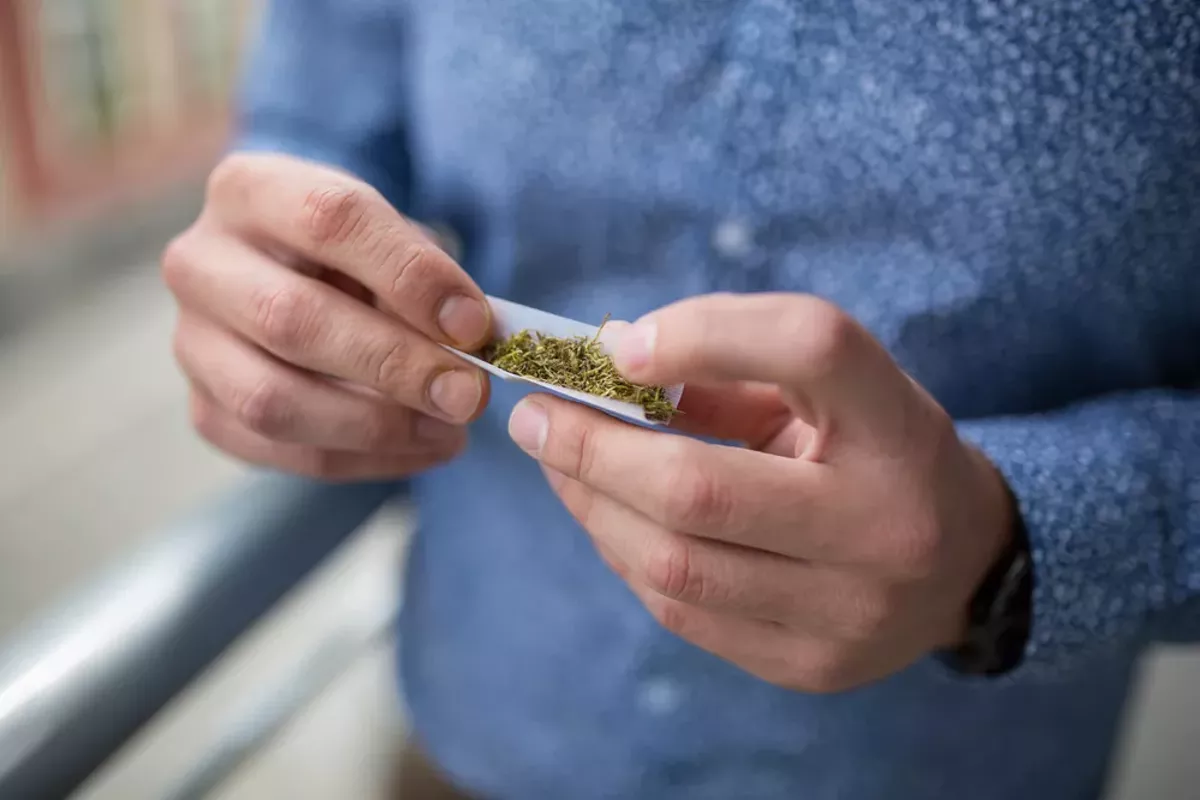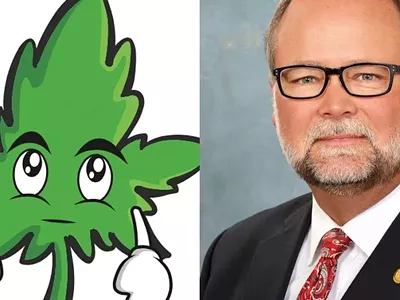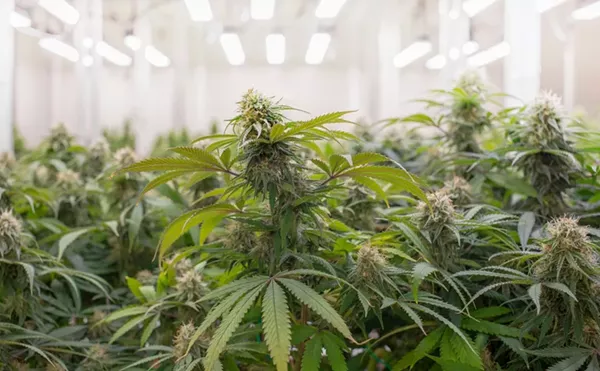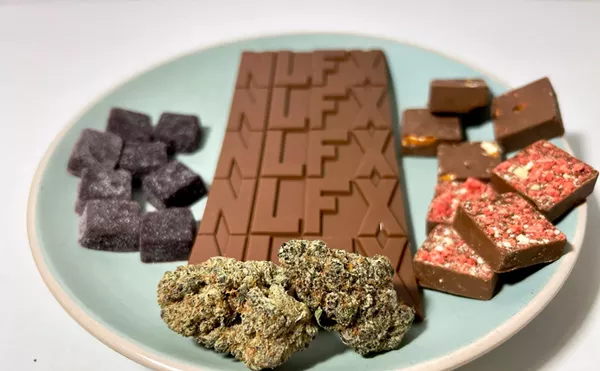

Audio By Carbonatix
[
{
"name": "GPT - Leaderboard - Inline - Content",
"component": "35519556",
"insertPoint": "5th",
"startingPoint": "3",
"requiredCountToDisplay": "3",
"maxInsertions": 100,
"adList": [
{
"adPreset": "LeaderboardInline"
}
]
}
]
Step into any well-appointed marijuana store or smoke shop and you will find a plethora of cannabis-based products and paraphernalia with which to use those products. Glass bongs of every shape and color adorn the shelves. There are vaporizers ranging from those that look like pens up to the large cone-shaped volcanoes.
There are enough edibles to stock a small candy store: chocolates, suckers, hard candies, and gummy candies. But there are also the cakes, cookies, cake pops, pies, and old school brownies, if your tastes lean toward the pastries.
There are high concentrate oils for eating and low concentrate oils for topical application. There are ointments and tinctures for whatever ails you. There are hash and dabs and wax and shatter. There are even medical marijuana suppositories out there for literally sticking something up your butt to deliver the goods.
There are so many ways to use marijuana that it can boggle the mind even without indulging in the stuff.
There are so many high tech gadgets, so many extracts, that it seems the traditional, humble joint will soon be lost in the sheer volume of what's available. Are we witnessing the end of the joint's run as the darling of the dank? Not so fast.
"It's still a joint for me," says local cannabis enthusiast Andre Godwin. "I'm going to keep smoking it. That's my preference."
There seems to be a lot of that going around. A customer I spoke with at a grow store last week says, "The joint will never go away."
For those of us who discovered marijuana before high technology did, the joint is the bedrock of getting high. All one needs to do is crumble up a bud and wrap it in a thin piece of paper, apply some fire to one end, and inhale through the other. It's simple, direct, and one is high within a few minutes.
Eating cannabinoids in oils or foods takes longer to get into your system. Edibles take at least a half hour and as long as two hours before taking effect.
The joint is one of those low tech things that are hard to improve on, like the wheel — although the vaporizer industry would tell you that their product provides a safer, cleaner process.
But the low-tech, hand-rolled cannabinoid delivery system is so simple and straightforward that it seems like it will remain the standard for as long as I can imagine. It's quick and reliable. If you're medicating, relief is but a few puffs away.
Now, there are some people who don't want to smoke anything. And there has been information circulated that marijuana is 20 times (or whatever alarmist number you choose) more carcinogenic than tobacco. It would seem that smoking anything is not good for your lungs. That's probably true. However, a number of sources, including a report from the National Center for Biotechnology Information found no connection between marijuana smoke and lung or rectal cancers.
So smoking marijuana does not seem to be a beyond-the-pale health hazard.
Is smoking joints a generational thing? Maybe in a distant future when the choices for cannabinoid delivery are even more numerous than today the joint will slack off. Maybe when people have stories to tell about their first high and it involved a slice of pie or a pill they stuck under their tongue, the joint will seem as archaic and dangerous as the ancient Chinese practice of ingesting mercury. But not yet.
I spoke with a young professional in his 30s who grew up during this explosion of varieties marijuana products. He agrees that the joint is here to stay.
"It's like a social thing with the joint, wherever you go," he says. "It's like having a beer; the joint is just everywhere."
While vaporizers and oils are useful, functional, and are even preferred by some, there is a certain sterility to the experience. It doesn't compare to the ritual of breaking down the bud, smelling the bouquet of the flower as it's prepared for consumption, feeling the stickiness of the oils on your fingers, twisting it up and finally lighting it. The thickness and volume of smoke rolling across your tongue and the pungent odor in the air feel like home to older users.
"Ritual, oh gosh yeah, it's definitely a ritual," says Godwin. "I get out my tray, my grinder, the papers. ... It's a natural taste, it's what I started with. I don't really care for blunts. Papers are what I started my herb journey on."
The blunt, marijuana rolled in a tobacco leaf, never became as ubiquitous as the joint. Tobacco just makes me nauseous, so wrapping marijuana in it is a nonstarter, although I can see the attraction to folks who already smoke cigarettes.
The joint is an unassuming little thing. To see it, one could wonder what is the big deal. Why would this small paper tube filled with dried flower parts be at the center of a worldwide war on drugs? Why would it arouse such passions and antipathy?
Just as attitudes about the war on drugs are changing, the way we see and talk about marijuana are changing. The way we use it is changing. Someday in a distant future that change may eliminate the joint from consideration.
In the meantime, as Cypress Hill told us, "Roll it up, light it up, smoke it up. Inhale, exhale." It's simple.
Petition signatures validated
It's on now. Last week, the Michigan Board of State Canvassers voted unanimously to approve the signatures on the Coalition to Regulate Marijuana Like Alcohol petitions, which puts the question of legalizing recreational use of marijuana on the fall ballot. Legalization would allow adults 21 and over to grow, possess, and use limited amounts of marijuana. Public consumption and driving under the influence are not allowed. Now only a legislative action to go ahead and legalize recreational marijuana before the election would stop a vote.
At this point recreational legalization in the state seems nearly assured. Recent national polling shows support for recreational legalization at 63 percent; the same poll found 93 percent support for medical use. The record shows that nearly every time that voters get the choice to relax marijuana laws, they do.
In addition, Democrat attorney general candidate Dana Nessel, in stark contrast to outgoing attorney general and current Republican gubernatorial candidate Bill Schuette, has made legalization a cornerstone of her campaign. Her vocal support of legalization helped pull together the coalition that secured her nomination at the April 15 state Democratic convention.
State legislators have 40 days after receiving a letter from the Board of State Canvassers to either enact a law to legalize marijuana or place it on the ballot. Creating their own law gives legislators some leeway in setting how legalization will be handled. State law for initiatives mandates that legislative changes have the support of 75 percent of Congress — a difficult bar to pass over.
Stay on top of Detroit news and views. Sign up for our weekly issue newsletter delivered each Wednesday.






